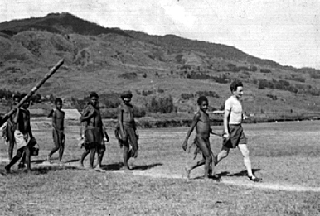
First Encounter: Roll 001
Viewed and Discussed on July 17, 1996
| The following record of a discussion between
Allison and Marek Jablonko shows the importance of dialogue in
triggering ways of looking at the images and new ideas. Allison: "How would you choose any pictures from that first day? Are there any you would want to choose"? Marek: "I don't know what 001:08 was supposed to be. The pledge of allegiance"? Allison: "Perhaps you were saying 'How' to the 'Indians'"! Marek: "I don't know which pictures to choose. The thing is...I guess...I was just overwhelmed by the number of the people who came to greet us and help us with our cargo. And I had difficulty understanding why they were so helpful, friendly, and out-going to someone they have just laid their eyes upon for the first time, and they had no idea what kind of a person I am and how I would treat them. Having lived for a number of years in an Anglo-Saxon country, I was surprised to see how much body contact the Maring were using. Surprisingly, I did not feel uncomfortable holding hands with a young Maring boy while we walked along the side of the airstrip. I would definitely choose 001:04,05, or 06. I think 04 is best." |

001:06
| Allison: "What I like about 001:06 is that the
hilltop is visible. Also I like your body attitude: you are really
striding out. Now, if I hadn't heard what you just said about being
overcome, I would have read your posture as 'being fully in charge.'
It is a typical, self-confident, activity-oriented male posture among
Europeans. I would certainly read it as a display of the overweening
Westerner. Not only do the stuck-out chest, the pulled-back shoulders
and the upright head contrast to the posture of the Maring men seen
on the same photo, but there is a sharp contrast in the way the legs
are used in walking. You have a wide stride, in which the thighs
separate and the lower-leg continues this diagonal direction. The
legs of all the other people in the picture are different: the thighs
remain virtually together, while the lower legs seem to move
underneath, carrying the person along. I feel this is familiar from
the girl's dance, but here it is men. This is perhaps the only
picture we have of men walking along a flat open path. This is not
the sort of surface which they were used to moving over. But you had
spent most of your life striding along such paths, sidewalks, and
streets, as a matter of course. No wonder you moved this way. It is
only if the photograph is taken out of its environmental movement
context that a viewer would construe this as the 'White Bossman'
stereotype. This 'striding information' is not visible in 001:04 or
001:05 which are head-on shots." Marek: "I think I would take 001:09. I don't think 001:10 is necessary, but I would certainly take 001:16. I can't connect 001:10 with 001:09. I can't see myself." Allison: "I think you are off to the left. This is an example where we ought to enlarge it on the screen to see if we can get that information out of it. I like the sequence from 001:08 - 001:10 or 001:11. I started out [as the camera person]being interested in you making an initial speech of greeting, but, instead of focussing into the core of that -- spatially, frontally -- I moved further and further away, getting the larger spatial context, but missing relevant gestures and juncture points. This is an example of snapping for space and setting rather than for flow of interaction. "The next sequence is Kavali taking names of people who are volunteering to carry our cargo for us. It goes from 001:12-001:14 and may include 001:11. Both 001:11 and 001:13 are my initial reaction to these New Guinea Highlanders that I was seeing for the first time." Marek: "001:17 shows me sitting with a group of men near one of the houses where they will sleep. On 001:14,where Kavali is taking names, there is the young man with the bark head covering, standing in such a typical posture: arms folded across the chest [waiting, keeping warm]." Allison: "Also 001:10 is the back view of a man holding one wrist in the other hand, another very familiar posture." Marek: "We want 001:33 because it shows how small the plane is. Then I would take 001:37 to show the policeman in his belt and T-shirt, though it is too close to see the laplap, which is also part of his uniform." |
Another Look
April 16, 1997
| Allison: "The 37 photos on Roll 001 represent
our
initial contact with the Maring. We were not yet in Maring territory,
but in a transition zone between 'the outside world' and 'our field
location.' What is most striking about the photos from those two days
is their virtual exclusion of the European world which formed Simbai
and which supported our own activities. "We were not in Simbai very long, and we were preoccupied with getting our possessions organized for the walk. Nevertheless, it is noteworthy that there is not a single photo of the mission station or of any of the mission personnel. The comment in the Photographic Index mentions Alan Johnson, the patrol officer at the time, as being present while we were unloading cargo (001:36). Careful scrutiny of the contact print reveals two European men, but they are definitely not 'the subject' of the photo." |
Copyright © 1999-2011 Allison Jablonko. All Rights Reserved.